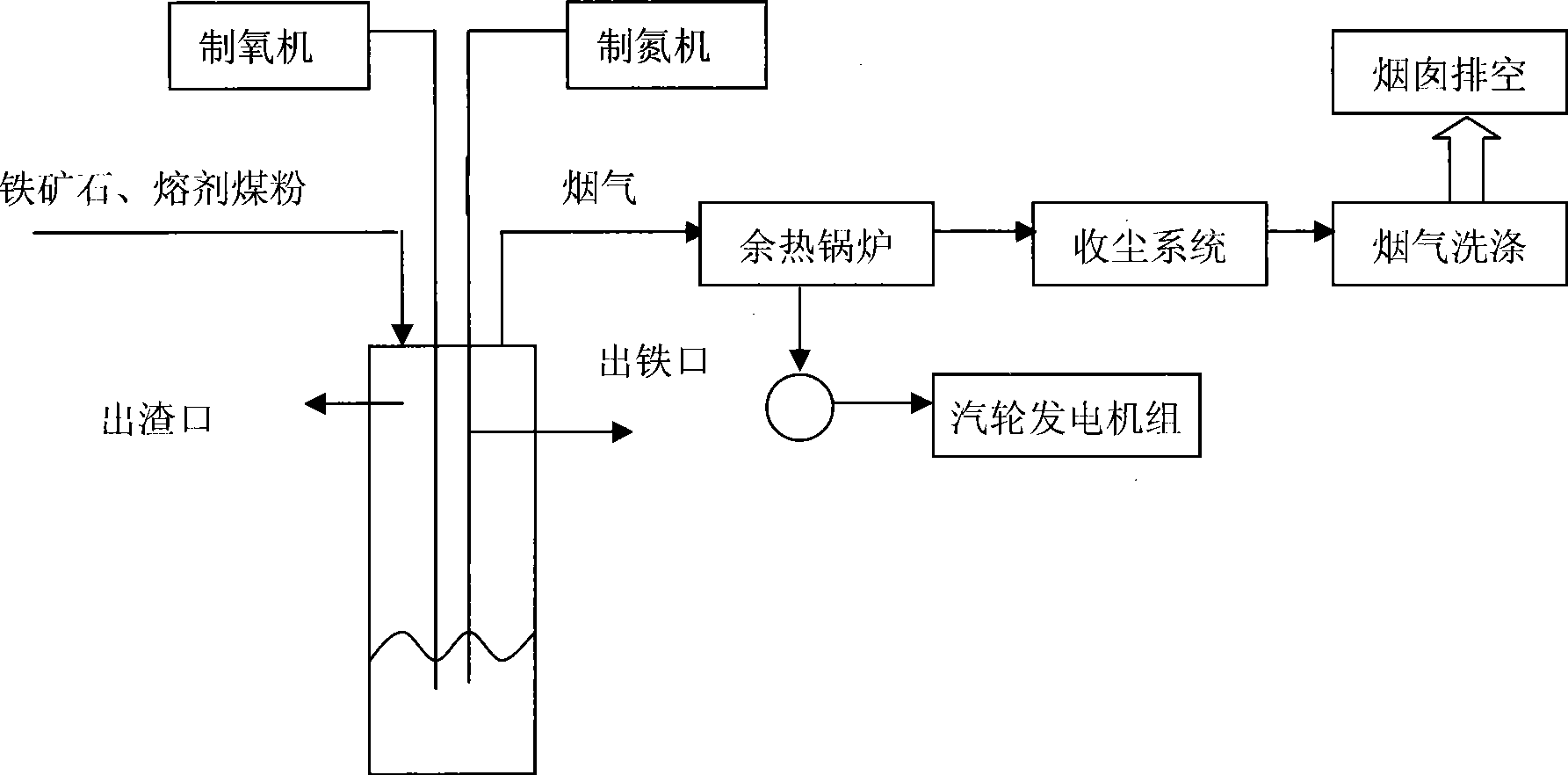Method for preparing molten iron by utilizing oxygen top blown smelting reduction ironmaking
A technology of oxygen top blowing and molten iron, applied in the fields of energy and metallurgy, can solve the problems of declining market competitiveness of enterprises, rising steel production costs, low thermal efficiency, etc., achieving the effect of achieving clean production, reducing infrastructure investment and short construction period
- Summary
- Abstract
- Description
- Claims
- Application Information
AI Technical Summary
Problems solved by technology
Method used
Image
Examples
Embodiment 1
[0034] Iron ore (main chemical composition / %: TFe=58.08, CaO=1.46, MgO=1.97, SiO 2=8.02, S=0.23, P=0.17) broken to 2-25mm, the flux and anthracite (main chemical composition / %: volatile matter (VM)=6.86, fixed carbon (FC)=80.63, ash content=11.61, analysis Water = 0.81) is broken to 2-25mm, and then the data obtained from the batching calculation are fully mixed and added to the smelting reduction furnace from the feed port on the furnace top. The furnace temperature is maintained at 1550 ° C ~ 1750 ° C during normal production. The pressure is maintained at 0.2-1MPa. After one cycle (3 hours) of reaction, high-quality molten iron containing P<0.015% can be obtained. Since only about 20% of S can be removed during the reaction process, the molten iron must be After desulfurization treatment, it is sent to the steelmaking workshop.
Embodiment 2
[0036] Iron ore (main chemical composition / %: TFe=51.5, CaO=2.25, MgO=3.13, SiO 2 =12.5, S=0.2, P=0.15) broken to 2-25mm, the flux and lean coal (main chemical components / %: volatile matter (VM)=13.42, fixed carbon (FC)=76.07, ash content=10.21, Analysis water = 2) Broken to 2-25mm, and then the data obtained from batching calculation are fully mixed and evenly added to the smelting reduction furnace from the feed port on the top of the furnace. The blowing pressure is maintained at 0.2-1MPa. After one cycle (3 hours) of reaction, a high-quality molten iron containing P<0.013% can be obtained. Since only about 20% of S can be removed during the reaction process, the molten iron must be removed before entering the next process. After desulfurization treatment, it is sent to the steelmaking workshop.
Embodiment 3
[0038] Iron ore (main chemical composition / %: TFe=57.79, CaO=2.53, MgO=2.07, SiO 2 =9.72, S=0.25, P=0.08) broken to 2-25mm, the flux and reduced coal (main chemical components / %: volatile matter (VM)=7.06, fixed carbon (FC)=82.03, ash content=10.06, Analytical water = 1.71) is broken to 2-25mm, and then the data obtained from the batching calculation are fully mixed and added to the smelting reduction furnace from the feed port on the furnace top. The blowing pressure is maintained at 0.2-1MPa. After one cycle (3 hours) of reaction, a high-quality molten iron containing P<0.015% can be obtained. Since only about 20% of S can be removed during the reaction process, the molten iron must be removed before entering the next process. After desulfurization treatment, it is sent to the steelmaking workshop.
PUM
| Property | Measurement | Unit |
|---|---|---|
| particle size | aaaaa | aaaaa |
Abstract
Description
Claims
Application Information
 Login to View More
Login to View More - R&D
- Intellectual Property
- Life Sciences
- Materials
- Tech Scout
- Unparalleled Data Quality
- Higher Quality Content
- 60% Fewer Hallucinations
Browse by: Latest US Patents, China's latest patents, Technical Efficacy Thesaurus, Application Domain, Technology Topic, Popular Technical Reports.
© 2025 PatSnap. All rights reserved.Legal|Privacy policy|Modern Slavery Act Transparency Statement|Sitemap|About US| Contact US: help@patsnap.com

